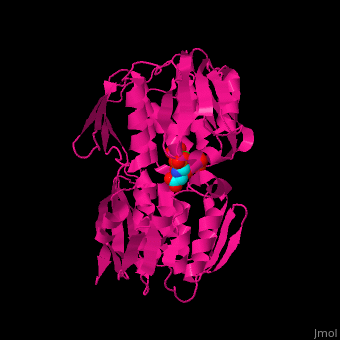Function
5-enolpyruvylshikimate 3-phosphate (EPSP) synthase is a key enzyme for the biosynthesis of aromatic amino acids in plants and many microbes. EPSP synthase catalyzes the addition of phosphoenol pyruvate (PEP) to shikimate-3-phosphate (S3P), generating 5-enolpyruvylshikimate-3-phosphate, which is a precursor for phenylalanine and tyrosine[1]. EPSP synthase is a target for herbicides like Roundup, which contain glyphosate, an inhibitor of EPSP synthase. Herbicide resistant plants contain an glyphosate insensitive version of EPSP synthase derived from Agrobacterium sp strain CP4, so it is called CP4 EPSP synthase. [2],
Structural insights
The enzyme has two domains, with the active site found in the interdomain cleft . There is a substantial structural change upon substrate binding, resulting in a conformation. . Glyphosate (also known as Roundup) occupies the of the second substrate, phosphoenol pyruvate [3]. Interestingly CP4 EPSP synthase still binds glyphosate in the absence of PEP, but a conformational change in glyphosate to accommodate a steric clash with shortens the length of glyphosate, from 7.3 angstroms to 6.67 angstroms, and changes the IC50 by a factor of over 4,000, from 2.5 micromolar to 11 millimolar.
3D structures of EPSP synthase
EPSP synthase 3D structures

